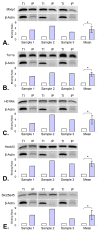Thyroid hormone-regulated gene expression in juvenile mouse liver: identification of thyroid response elements using microarray profiling and in silico analyses
- PMID: 22206413
- PMCID: PMC3340398
- DOI: 10.1186/1471-2164-12-634
Thyroid hormone-regulated gene expression in juvenile mouse liver: identification of thyroid response elements using microarray profiling and in silico analyses
Abstract
Background: Disruption of thyroid hormone signalling can alter growth, development and energy metabolism. Thyroid hormones exert their effects through interactions with thyroid receptors that directly bind thyroid response elements and can alter transcriptional activity of target genes. The effects of short-term thyroid hormone perturbation on hepatic mRNA transcription in juvenile mice were evaluated, with the goal of identifying genes containing active thyroid response elements. Thyroid hormone disruption was induced from postnatal day 12 to 15 by adding goitrogens to dams' drinking water (hypothyroid). A subgroup of thyroid hormone-disrupted pups received intraperitoneal injections of replacement thyroid hormones four hours prior to sacrifice (replacement). An additional group received only thyroid hormones four hours prior to sacrifice (hyperthyroid). Hepatic mRNA was extracted and hybridized to Agilent mouse microarrays.
Results: Transcriptional profiling enabled the identification of 28 genes that appeared to be under direct thyroid hormone-regulation. The regulatory regions of the genome adjacent to these genes were examined for half-site sequences that resemble known thyroid response elements. A bioinformatics search identified 33 thyroid response elements in the promoter regions of 13 different genes thought to be directly regulated by thyroid hormones. Thyroid response elements found in the promoter regions of Tor1a, 2310003H01Rik, Hect3d and Slc25a45 were further validated by confirming that the thyroid receptor is associated with these sequences in vivo and that it can bind directly to these sequences in vitro. Three different arrangements of thyroid response elements were identified. Some of these thyroid response elements were located far up-stream (> 7 kb) of the transcription start site of the regulated gene.
Conclusions: Transcriptional profiling of thyroid hormone disrupted animals coupled with a novel bioinformatics search revealed new thyroid response elements associated with genes previously unknown to be responsive to thyroid hormone. The work provides insight into thyroid response element sequence motif characteristics.
Figures




Similar articles
-
Hepatic gene expression changes in hypothyroid juvenile mice: characterization of a novel negative thyroid-responsive element.Endocrinology. 2007 Aug;148(8):3932-40. doi: 10.1210/en.2007-0452. Epub 2007 Apr 26. Endocrinology. 2007. PMID: 17463053
-
Thyroid hormones directly activate the expression of the human and mouse uncoupling protein-3 genes through a thyroid response element in the proximal promoter region.Biochem J. 2005 Mar 15;386(Pt 3):505-13. doi: 10.1042/BJ20041073. Biochem J. 2005. PMID: 15496137 Free PMC article.
-
Mouse sterol response element binding protein-1c gene expression is negatively regulated by thyroid hormone.Endocrinology. 2006 Sep;147(9):4292-302. doi: 10.1210/en.2006-0116. Epub 2006 Jun 22. Endocrinology. 2006. PMID: 16794015
-
Role of co-regulators in metabolic and transcriptional actions of thyroid hormone.J Mol Endocrinol. 2016 Apr;56(3):73-97. doi: 10.1530/JME-15-0246. Epub 2015 Dec 16. J Mol Endocrinol. 2016. PMID: 26673411 Review.
-
Non-classic thyroid hormone signalling involved in hepatic lipid metabolism.J Endocrinol. 2013 Feb 25;216(3):R47-57. doi: 10.1530/JOE-12-0542. Print 2013 Mar. J Endocrinol. 2013. PMID: 23297113 Review.
Cited by
-
Tissue Transglutaminase Knock-Out Preadipocytes and Beige Cells of Epididymal Fat Origin Possess Decreased Mitochondrial Functions Required for Thermogenesis.Int J Mol Sci. 2022 May 5;23(9):5175. doi: 10.3390/ijms23095175. Int J Mol Sci. 2022. PMID: 35563567 Free PMC article.
-
Thyroxine Induces Acute Relaxation of Rat Skeletal Muscle Arteries via Integrin αvβ3, ERK1/2 and Integrin-Linked Kinase.Front Physiol. 2021 Sep 14;12:726354. doi: 10.3389/fphys.2021.726354. eCollection 2021. Front Physiol. 2021. PMID: 34594239 Free PMC article.
-
Decreased translation of Dio3 mRNA is associated with drug-induced hepatotoxicity.Biochem J. 2013 Jul 1;453(1):71-82. doi: 10.1042/BJ20130049. Biochem J. 2013. PMID: 23586759 Free PMC article.
-
Toxicogenomic assessment of liver responses following subchronic exposure to furan in Fischer F344 rats.Arch Toxicol. 2016 Jun;90(6):1351-67. doi: 10.1007/s00204-015-1561-2. Epub 2015 Jul 21. Arch Toxicol. 2016. PMID: 26194646 Free PMC article.
-
Identification of a Nine-Gene Signature and Establishment of a Prognostic Nomogram Predicting Overall Survival of Pancreatic Cancer.Front Oncol. 2019 Sep 27;9:996. doi: 10.3389/fonc.2019.00996. eCollection 2019. Front Oncol. 2019. PMID: 31612115 Free PMC article.
References
Publication types
MeSH terms
Substances
Associated data
- Actions
LinkOut - more resources
Full Text Sources
Molecular Biology Databases
Miscellaneous

